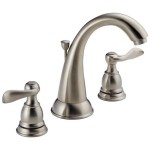How To Clean a Bathroom Sink
The bathroom sink is a high-traffic area prone to accumulating soap scum, toothpaste residue, hair, and other debris. Regular cleaning is essential not only for aesthetics but also to prevent the growth of bacteria and mold. This article provides a comprehensive guide to effectively cleaning a bathroom sink, covering various materials and cleaning methods.
1. Gather Necessary Cleaning Supplies
Before beginning the cleaning process, gather all the required supplies. This preparation ensures a smooth and efficient cleaning experience. Essential cleaning supplies include:
- Cleaning cloths or sponges: Microfiber cloths are ideal as they are highly absorbent and gentle on surfaces.
- All-purpose cleaner: Select a cleaner suitable for the sink material. Avoid abrasive cleaners on delicate surfaces.
- Baking soda: A natural cleaning agent effective for removing stains and deodorizing.
- White vinegar: Another natural cleaning solution useful for dissolving mineral deposits and soap scum.
- Distilled water: Recommended for rinsing to prevent water spots, especially on chrome fixtures.
- Scrub brush: A small brush with stiff bristles is helpful for cleaning around the drain and faucet.
- Rubber gloves: Protect hands from cleaning agents and bacteria.
- Spray bottle: Useful for applying cleaning solutions evenly.
2. Identify the Sink Material
Different sink materials require specific cleaning approaches. Identifying the sink material is crucial to avoid damage. Common bathroom sink materials include:
- Porcelain: A durable and common material that can withstand most cleaning agents. However, avoid abrasive cleaners that may scratch the surface.
- Ceramic: Similar to porcelain, ceramic sinks are generally easy to clean with standard cleaning solutions.
- Vitreous china: A type of ceramic fired at high temperatures, making it resistant to staining and scratching. General-purpose cleaners are usually sufficient.
- Acrylic: A less expensive option that is prone to scratching. Use non-abrasive cleaners and soft cloths.
- Stainless steel: Durable and resistant to rust, stainless steel sinks can be cleaned with specialized stainless steel cleaners or mild dish soap.
- Composite materials: These sinks are composed of various materials and may require specific cleaning instructions from the manufacturer.
Consult the manufacturer's guidelines for specific cleaning recommendations for your sink material.
3. Implement the Cleaning Process
Once the necessary supplies are gathered and the sink material is identified, the cleaning process can begin. Follow these steps for effective cleaning:
- Clear the sink area: Remove any items such as soap dispensers, toothbrushes, and other toiletries from the sink area.
- Rinse the sink: Wet the entire surface of the sink with warm water to loosen debris.
- Apply the cleaner: Apply the chosen cleaning solution to the sink surface. For a natural cleaning solution, sprinkle baking soda over the damp surface and then spray with white vinegar. Allow the mixture to fizz for a few minutes.
- Scrub the sink: Using a soft cloth or sponge, scrub the sink thoroughly, paying attention to stained areas and around the drain. Use a scrub brush for hard-to-reach areas.
- Clean the faucet and handles: Wipe down the faucet and handles with the cleaning solution, ensuring all areas are cleaned.
- Rinse thoroughly: Rinse the entire sink and faucet with warm water until all traces of cleaner are removed. Use distilled water for a spot-free finish.
- Dry the sink: Dry the sink and faucet with a clean, dry cloth to prevent water spots and maintain shine.
- Clean the drain: Pour baking soda and vinegar down the drain, followed by hot water, to eliminate odors and prevent clogs.
Regular cleaning, ideally once or twice a week, will prevent the buildup of grime and maintain the appearance and hygiene of the bathroom sink.
4. Addressing Specific Stains
Stubborn stains may require specific treatment. Here are some tips for removing common bathroom sink stains:
- Hard water stains: Soak a cloth in vinegar and place it over the stain for 30 minutes. Then scrub and rinse.
- Rust stains: Use a commercial rust remover or a paste of lemon juice and salt. Apply the paste to the stain, let it sit for a few minutes, then scrub and rinse.
- Toothpaste stains: Make a paste of baking soda and water. Apply it to the stain, scrub gently, and rinse.
Always test cleaning solutions on an inconspicuous area first to ensure they do not damage the sink material.

How To Clean A Bathroom Sink Maids By Trade

How To Clean Your Bathroom Sink Cleaning Services Denver Co

6 Tips To Deep Clean And Sanitize Your Bathroom Healthyhome

How Tо Clean A Bathroom Sink Simple Household S

How To Clean A Sink Things

Bathroom Cleaning S How To Clean The Frugal Family Home

Bathroom Cleaning 101 What You Need To Know Home Matters Ahs

How To Clean A Bathroom Sink No Matter The Material

How To Clean Bathroom Sink Counters Daily Routine Periodic Deeper Cleaning Tasks

How To Clean A Bathroom Sink
Related Posts







